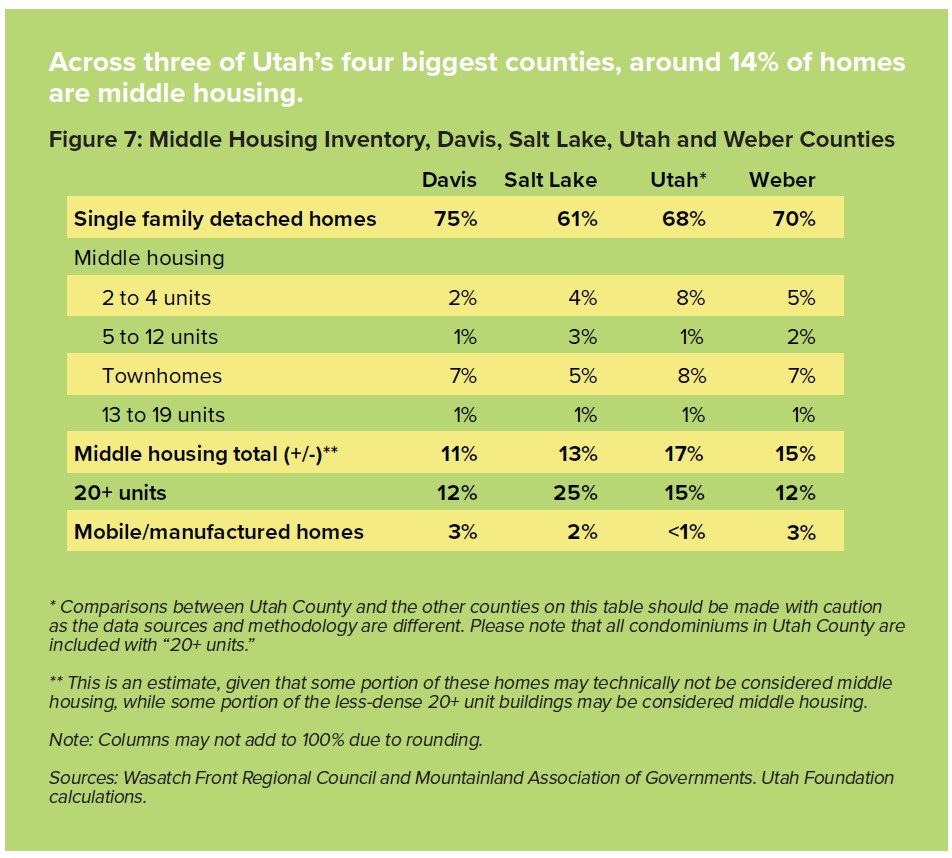MIDDLE HOUSING STUDY
Check out the other sections of the Middle Housing Study. Links will become live as reports are published
“Missing Middle Housing” refers to housing that occupies the “middle” ground between single-family homes on large lots and large apartment complexes. It can encompass a variety of multi-unit housing buildings that are house-scale, facilitate neighborhood walkability, accommodate changing demographics and preferences, and are available to people with a range of incomes. Because it is scarce in some communities, it is referred to as the “missing middle.”
Middle housing offers the potential to increase the supply of housing, but at a scale that is not objectionable to most neighbors and in a manner that can improve upon neighborhoods. There are obstacles to increasing this type of housing, though they are not insurmountable. This guide explores Utah’s housing challenges, the significance of middle housing in addressing those challenges, Utahns’ design preferences, and obstacles and opportunities for increasing the supply of middle housing.
The guide is separated into four parts. The first part examines Utah’s housing problem and introduces middle housing as one means of addressing it. This part (Part II) examines the prevalence of middle housing in the four largest Utah counties and the relevant development trends.
KEY FINDINGS OF THIS REPORT
- Middle housing offers an important response to Utah’s need for more housing choices at a variety of price points, to the growing demand for walkable communities, and to the increasing number of households with fewer and older people.
- While middle housing might take the form of a duplex, a six-unit townhome or a 12-unit apartment, the number of units alone is an oversimplification of middle housing, which depends on the neighborhood and is defined by multiple characteristics.
- In Davis, Salt Lake, Utah and Weber counties, about 14% of housing units are middle housing. This suggests that there may be room to expand these options – especially in light of high costs, changing preferences and shifting demographics.
- In Utah’s four largest counties, townhomes are the most common type, followed by small multiplexes (duplexes, triplexes and fourplexes).
- Middle-housing development has shifted over time. Most of Utah’s small multiplexes were built between the early 20th century and the 1980s, but since 2000, townhomes have become the predominant middle-housing type.
- The amount, proportion and types of middle housing vary significantly within counties, with some localities bringing in a wider diversity of housing types.
Read the full report: Is the Middle Missing? A Guide to Expanding Options for Utah Homebuyers and Renters – What is the Middle Housing, and Where is It?
See a zoomable version of a map showing the distribution of middle housing across Weber, Davis and Salt Lake counties at: https://www.utahfoundation.org/middle-housing-map/.
Special thanks to Salt Lake County, the Sorenson Legacy Foundation, the Utah League of Cities and Towns, the Wasatch Front Regional Council and Y2 Analytics for providing project-based support.


